9 Plant-Based Holiday Recipes Even Meat Eaters Will Love
Updated: Nov. 15, 2022
The holidays can be an indulgent time of year. With these plant-based recipes and tips, see how this jolly season can also be a time of good health for you … and the planet.
Our editors and experts handpick every product we feature. We may earn a commission from your purchases.
Celebrate the holidays with plants
‘Tis the eating season! That means it’s time for holiday turkeys and hams, prime rib, party meatballs, sausage stuffing, and egg nog. But if you’re looking for more plant-based recipes this holiday season—and there are many good reasons to do so, from personal to planetary health—you are in luck.
Despite the prevalence of meat in holiday cooking, it is possible to eat a plant-based diet during the holidays without missing out on any of the joyful scrumptiousness or good cheer.
On top of that, you can do so while giving back to the planet by way of what you put on your plate. Here are a few plant-based recipes that registered dietitians love serving during the holiday season.
Health benefits of plant-based recipes
Veganism is no longer a fringe diet.
According to Ipsos Retail Performance, over a 15-year period from 2004 to 2019, the rise of plant-based eaters in the United States grew from 290,000 to 9.7 million. And that’s a positive thing, since plant-based foods can offer a significant boost to your health in lieu of animal-based foods.
Potential health benefits of a plant-based diet include protection against obesity, heart disease, and so much more.
More specifically, a systematic review published in Diabetes, Metabolic Syndrome and Obesity: Targets and Therapy found that plant-based diets may improve weight status due to an increased intake of fiber and a reduced intake of calories (energy).
A separate systematic review published in 2021 in The Journal of Nutrition suggests a vegan diet may offer significant benefits for people with type 2 diabetes, while offering a slight advantage related to cardiovascular health.
A study published in 2021 in Nutrients found that a vegan diet may be associated with a reduced risk of metabolic syndrome (a condition that heightens the risk of diabetes, heart disease, and stroke).
And according to a 2021 systematic review and meta-analysis of cohort studies in Critical Reviews in Food Science and Nutrition, plant-based diets show a potential to protect against mortality from chronic disease.
So yes, plant-based recipes can definitely be good for you.
(Learn what exactly meatless meat means.)
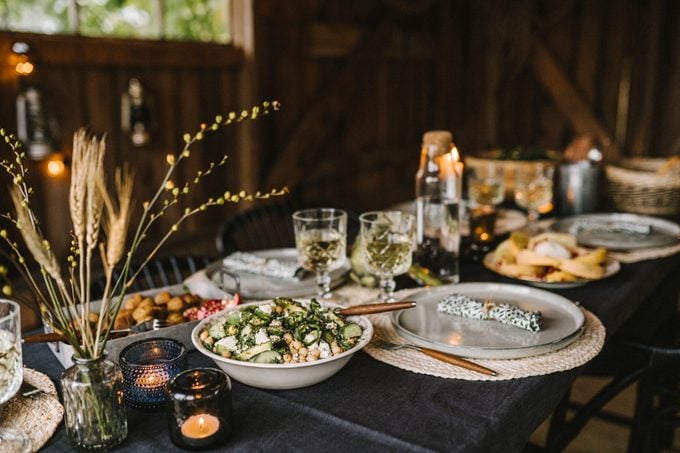
Culinary benefits of plant-based recipes
But will eating just plants make you feel like you’re missing out on savoriness? Nope, it doesn’t have to. You can absolutely get all of the tastebud-friendly qualities you’re hoping for by following a few simple strategies.
In general, you’ll want to consider taste, texture, and eye appeal when trying plant-based recipes for the holidays (or any day).
Vegan tricks of the trade
If you need or want to add plant-based recipes to your holiday table, don’t just plop a slab of plain tofu on a plate in place of that succulent roasted turkey.
Vegan dishes can offer plenty of palatability when you treat them with love and care, like any other part of the meal. Try a few (or all) of these tips for choosing and preparing plant-based recipes:
- Serve up entrées that offer appealing heartiness, such as those featuring eggplant, cauliflower, winter squash, pulses (dry beans, peas, and lentils), mushrooms, and/or sweet potatoes, like mushroom and sweet potato pot pie. Also, consider meaty swaps, like wholesome, plant-based sausage instead of the pork-based stuff.
- If you pick tofu, tempeh, or seitan, know that it can be helpful to marinate it before preparation to punch up flavor—or try a seasonal stir fry, like this tofu stir-fry with Brussels sprouts.
- Go beyond raw. For salads, include at least one pan-grilled or roasted ingredient, like my tahini Caesar-style salad with roasted carrot chips. Or opt for a filling grain salad instead of a leafy one, such as lemon rice salad.
- Plan a bit of comfort into the meal, like creamy vegan pumpkin pasta “alfredo” or vegan mac and cheese. Or try twists on holiday classics, such as vegan green bean casserole or citrus sweet potatoes.
- Add pops of color and texture for eye appeal. Think rainbow carrots, purple cauliflower, sprinkles of pomegranate arils, and even popcorn as “croutons” for soup. Check out my roasted carrots with spicy coriander avocado puree for a little inspiration. Do play up the fresh herbs, too.
Think outside the holiday box
Don’t feel like you’re required to stick to just the classics. Serve whatever you think will satisfy the most palates. Focus on fun, whether you’re serving traditional or not-so-traditional holiday eats and treats.
My no-recipe-required plant-based splatter platter (see below) is what nontraditional fun can look like. And remember, even if not a typical holiday dish this year, it’ll become a tradition if you make it again next year.
Think tweaks
Don’t complicate things. Some of your holiday favorites may already be vegan (hello, cranberry sauce) or vegetarian and only need a slight tweak to make them into fully plant-based recipes (hi there, mashed potatoes).
For example, those comforting mashed potatoes can be made with soft cashew cheese, dairy-free sour cream alternative, roasted garlic, vegan butter, and/or truffle oil. And, of course, there are ready-made products that can help you out in a pinch (think Tofurky Plant-Based Holiday Feast or Gardein Plant-Based Turk’y Roast).
Think streamlined
Don’t stress out. When you need to serve dishes to both meat lovers and plant fanatics, streamline the menu so that many of the same dishes can be served to everyone.
For instance, prepare the same starter, salad, soup, and/or side for all. Meatless dishes that can be a delight for anyone’s tastebuds include hummus, cranberry salad, vegetarian gravy, roasted Brussels sprouts, and vegan peppermint bark. The plant-based recipes below are taste winners.
Check out vegan Thanksgiving recipes and vegan Christmas dinner recipes for lots more holiday-friendly ideas, too. And aim for thoughtful plating, not presentation perfection.
Planetary benefits of plant-based recipes
Beyond healthfulness and taste, choosing plant-based recipes is also generally better for our climate and natural environment.
Overall, when compared with animal production, the production of plants for our diet requires far fewer environmental resources and emits significantly less greenhouse gases (GHGs), such as carbon dioxide (CO2), into the atmosphere.
The impact of animal protein
Researchers found beef production can create as much as 105 kilograms of CO2 equivalents. Meanwhile, plant-based proteins, including beans and peas, can create as little as 0.3 kg of CO2 equivalents per 100 grams of protein, according to the same research published in the journal Science.
Animal agriculture is also inefficient, taking up the majority of all land used for agricultural purposes on the entire planet, while yielding a minority of our total food supply—which can ultimately damage our ecosystem.
Plus, plants don’t belch out methane (a potent greenhouse gas) into the atmosphere like cows can. A reduction in emissions is needed right now to keep our planet from getting warmer and to prevent a worsening of our global climate crisis.
Climate research
Recent studies support the sustainability of plant-based eating.
A study published in Nutrients in 2021 finds that when considering food production, a vegan diet needs fewer environmental resources than an omnivorous (both plants and animals) eating style.
And results of a study in Frontiers in Nutrition suggests the more plant-based the diet is, the lower the GHG emissions, cumulative energy demand, and land use are.
Environmentally friendly kitchen tips
Also, keep in mind that if food ends up in landfills, it emits climate-harming methane (that potent GHG). So, throughout this holiday and beyond, try to choose foods that would have otherwise gone to waste.
For instance, get rescued food from a grocery delivery company, such as Hungry Harvest or Misfits Market. You could also reduce your use of plastics when storing holiday leftovers or offering “doggie” bags by opting for plastic-free options, such as Compostic resealable bags.
Plant-based recipes for the holiday season
Now, for holiday-time enjoyment that everyone can indulge in (including meat eaters), it’s time to put ideas into action for that plant-based meal.
I reached out to top culinary-savvy nutritionists for help in selecting these plant-based recipes. Plan to swap in one, two, or all nine of these traditional and nontraditional recipes this holiday season.
They prove that a plant-filled holiday meal can be as tasty, if not tastier, than a meatier one. Plus, you’ll feel good about doing your part to help our planet. Cheers!
Butternut squash soup with tahini and crispy chickpeas
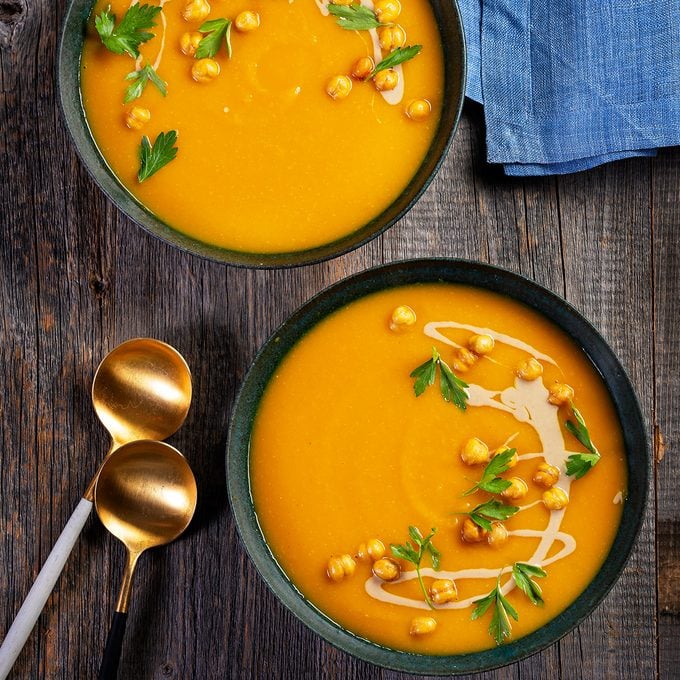
Courtesy Ellie-Krieger, RD
“Soups are not only nourishing and belly-warming; they are the ultimate make-ahead dish and a great way to incorporate seasonal produce,” says culinary nutritionist Ellie Krieger, a cooking-show host and award-winning cookbook author.
“This golden-hued recipe from my Whole in One: Complete Healthy Meals in a Single Pot, Sheet Pan or Skillet is one of my go-tos.”
Krieger recommends it as a starter to a holiday meal, but it can also be served as a vegan main course (if made with vegetable broth).
Serves 4; 2 cups each
Ingredients:
2 tablespoons olive oil
1 large onion, chopped
3 cloves garlic, chopped
2 pounds cubed (1-inch) butternut squash (about 7 ½ cups)
1 cup no-salt-added chickpeas, drained and rinsed
3/4 teaspoon salt
1/2 teaspoon ground cumin
1/4 teaspoon freshly ground black pepper
1/8 teaspoons ground turmeric
Pinch cayenne pepper
5 cups low-sodium chicken or vegetable broth*
1 tablespoon honey
2 tablespoons tahini
1/2 cup packaged crispy chickpea snacks (plain or lightly salted)
2 tablespoons chopped fresh parsley
Instructions:
Heat the oil in a large pot over medium heat. Add the onion and cook until softened, about 4 minutes. Add the garlic and cook 30 seconds more.
Stir in the squash, chickpeas, salt, cumin, black pepper, turmeric, and cayenne pepper.
Add the broth and bring to a boil, then reduce the heat to medium-low and simmer, covered, until the squash is very tender, about 20 minutes. Use a hand blender to puree until smooth. Stir in the honey.
Place the tahini in a bowl and stir in 2 tablespoons of cold water. Add more water by the teaspoon until the tahini is loose enough to be drizzled.
Serve the soup drizzled with the tahini, garnished with the crispy chickpeas and parsley.
*Note: Use vegetable broth to keep recipe 100 percent plant-based.
Pumpkin latkes
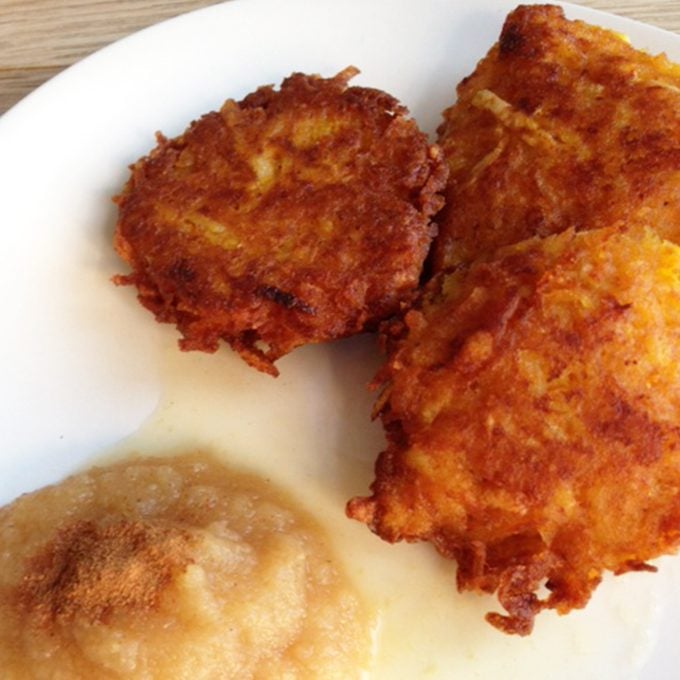
Courtesy of Frances Largeman-Roth, RDN
“This year Chanukah starts a few days after Thanksgiving, so I thought it would be fun to create a latkes recipe that uses leftover pumpkin puree,” says registered dietitian nutritionist Frances Largeman-Roth.
“Plus, you’ll get a healthy dose of immune-supporting beta-carotene from the pumpkin and potassium from the potatoes in this recipe, which is also eco-conscious as it helps you use up leftover pumpkin puree many of us have after Thanksgiving.”
Serves: 8
Ingredients:
1 pound Idaho potatoes
1/2 cup canned pumpkin puree
1/4 teaspoon salt
1/4 teaspoon pepper
1/2 yellow onion
1/2 cup olive oil
1 large egg, lightly beaten, or plant-based egg alternative*
Instructions:
Peel potatoes and coarsely grate by hand on the largest setting of a box grater, transferring to a large bowl of cold water as you grate. Place the onion in the freezer while you grate the potatoes.
Place a medium bowl under a fine mesh sieve and place the potatoes in the sieve. Use a large wooden spoon or spatula to press out as much of the moisture as possible.
Transfer potatoes to a large bowl. Grate the onion and add to the potatoes. Add the egg, pumpkin, salt, and pepper, and mix well.
Heat the oil in a 12-inch nonstick skillet over high heat until shimmering, but not smoking. Working in batches, spoon ¼ cup potato mixture per latke into the skillet, squeezing out any additional liquid before adding to the pan. Flatten the tops slightly with a spatula.
Reduce heat to medium-high and cook until the bottoms are browned, about 5 minutes. Turn latkes over and cook about 4 minutes more.
Transfer latkes to a paper-towel-lined plate to drain. Continue cooking latkes until all of the mixture is gone. Serve while hot with plain Greek yogurt (or plant-based alternative) and applesauce.
*Note: Use plant-based egg alternative to keep the recipe 100 percent plant-based.
Four-ingredient almond cream cheese
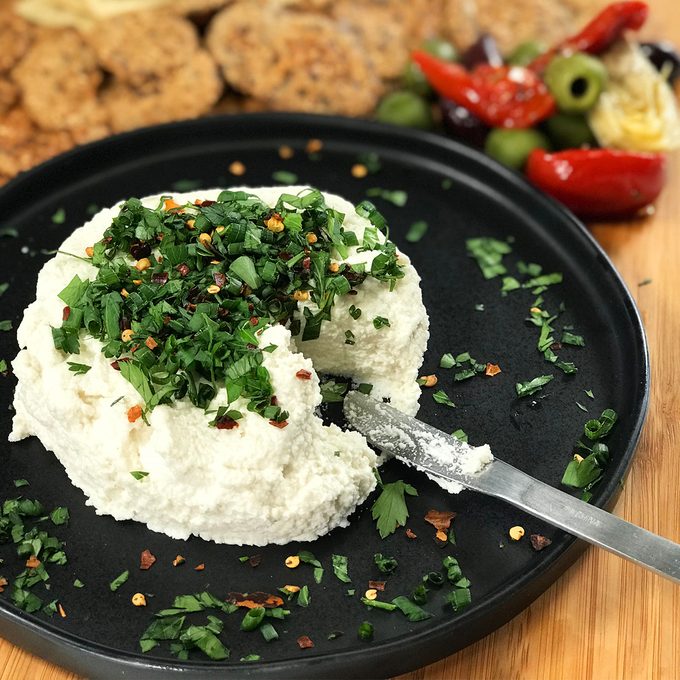
Courtesy of DJ Blatner, RDN
“This recipe proves that you don’t need salami and brie to make a gorgeous party snack board,” says registered dietitian nutritionist DJ Blatner, author of the Superfood Swap.
“I know it’s craveable because each time I serve it, everyone asks for the recipe—even hardcore meat eaters.”
Serves: 12
Ingredients:
2 cups blanched almonds, soaked overnight (about 8 to 12 hours) and drained
1/2 cup water
2 tablespoons white vinegar or fresh lemon juice
1/2 teaspoon sea salt
Optional: toppers like fresh chives, fresh parsley, and red pepper flakes
Instructions:
Add soaked almonds, water, vinegar or lemon juice, and sea salt to a blender.
Blend for 5 minutes, scraping down sides occasionally, until smooth.
Form into a molded round (like brie).
Top with chopped herbs and red pepper flakes, if using. Serve with whole-grain crackers and/or veggies.
Note: This can also be topped with sweeter things like chopped nuts, cinnamon, and maple syrup.
Plant-based splatter platter
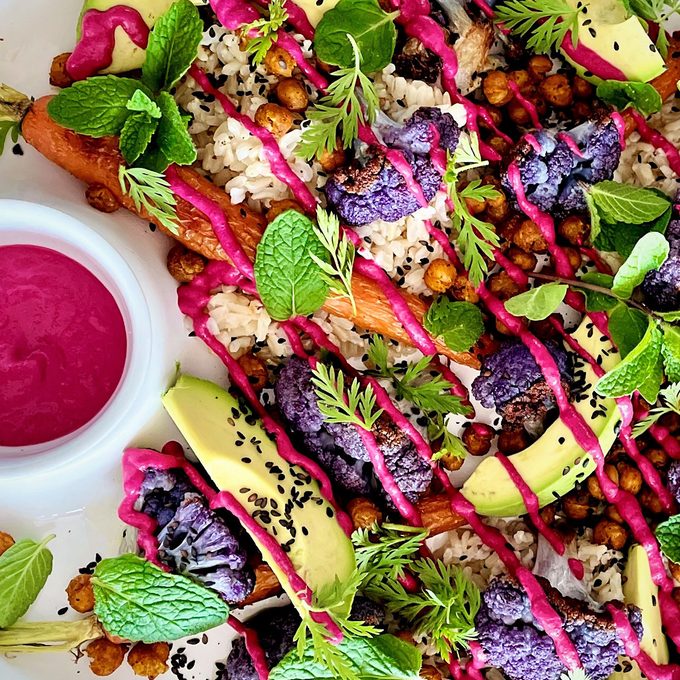
Courtesy of Jackie Newgent, RDN, CDN
To make this customizable showstopper, just spoon ingredients onto a platter and splatter it with a dressing. The result is a win-win for a special meal that’ll please anyone, especially those following a plant-based diet.
Another win is that you don’t need a recipe—just pick a food from each category below. Check out more variations for this splatter platter on my blog.
Makes 1 platter; servings vary
Ingredients:
Prepared grain: Try steamed organic brown rice or farro.
Cooked veggies: Try roasted carrot plus purple cauliflower—or leftovers!
Pulses: Try peppery turmeric roasted chickpeas or white beans.
Yum ingredient: Try avocado wedges or plant-based “cheese.”
Citrus wedges: usually lemon
Creamy vegan dressing: Try roasted beet tahini dressing or “honey” mustard dressing.
Seeds or nuts with salt: Try black sesame seeds plus sea salt or roasted, salted pistachios.
Fresh herbs: Try mint leaves and leafy carrot tops.
Instructions:
Build the platter with the first five ingredient in the order listed above.
Splatter, drip-n-splash (like you’re Jackson Pollock!), or drizzle with the dressing.
Finish with seeds or nuts with salt and fresh herbs, and serve.
Middle Eastern eggplant roast
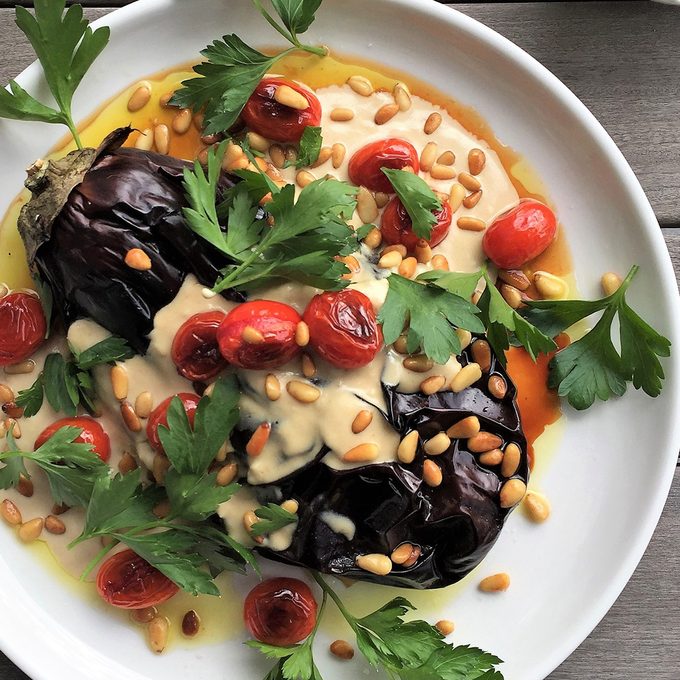
Courtesy of Jackie Newgent, RDN, CDN
An eggplant can be the star of the plate. Here it’s served whole as a roast to make everyone say “wowza” when they see and bite into it. All of the accessories for this roasted eggplant—lemony tahini sauce, fresh parsley, grape tomatoes, and pan-toasted pine nuts—make it festive, too.
Serves: 2
Ingredients:
1 large (1 1/4-pound/567-gram) eggplant, scrubbed (unpeeled)
3 tablespoons tahini
Juice of 1 lemon (3 tablespoons) plus extra lemon wedges, divided
2 tablespoons extra-virgin olive oil, divided
2 large garlic cloves, minced or creamed
1/2 teaspoon sea salt, divided
1/8 teaspoon ground cumin
2 handfuls fresh flat-leaf parsley leaves or microgreens
12 grape tomatoes, fresh or pan-charred
2 tablespoons pine nuts, pan-toasted
Instructions:
Grill or broil eggplant, turning occasionally, until the skin is just lightly charred, about 6 minutes. Then bake uncovered in 450 degrees F/230 degrees C oven until the eggplant is fully cooked and has an extra-soft texture, about 35 to 40 minutes.
Meanwhile, in a small bowl, whisk together until creamy the tahini, lemon juice, 1 tablespoon of the olive oil, the garlic, 1/4 teaspoon of the salt, the cumin, and cold filtered water (about 1 tablespoon) until desired saucy consistency is reached.
Transfer the eggplant to a small platter. Sprinkle with the remaining 1 tablespoon olive oil and 1/4 teaspoon salt, or to taste. Top with desired amount of the tahini sauce. Garnish with the parsley or microgreens, tomatoes, and pine nuts. Adjust seasoning.
Serve warm with the remaining tahini sauce and lemon wedges on the side.
Cauliflower steak with orange olive sauce
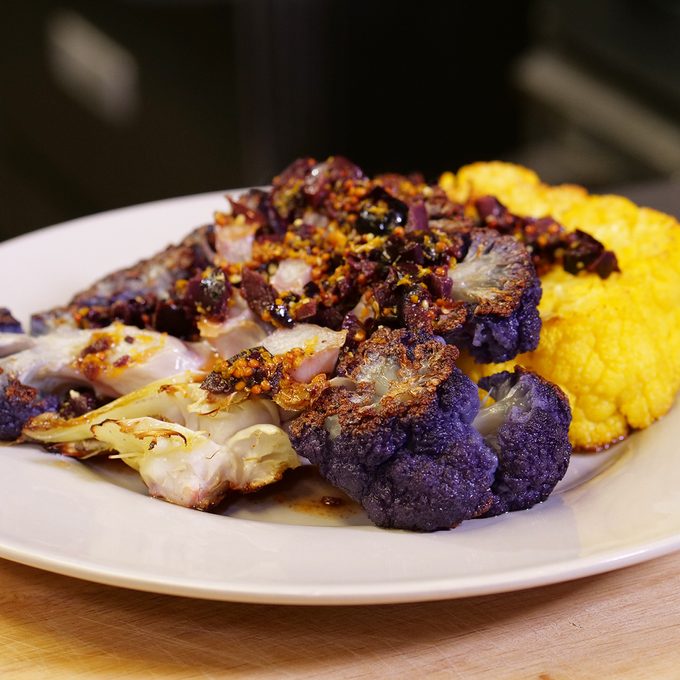
Courtesy Abbie Gellman, MS, RD, CDN
“I love this recipe, especially for those who have not had ‘cauliflower steaks’ before because it is so flavorful and filling, often surprising to first timers,” says registered dietitian and chef Abbie Gellman.
“As a cruciferous vegetable, cauliflower offers a wide variety of nutrients.”
Gellman recommends using different colors of cauliflower—orange, purple, and white—since it looks beautiful and each color provides a slightly different polyphenol (antioxidant) profile.
Serves: 4
Ingredients:
1 large head cauliflower, at least 2 pounds*
1/3 cup extra-virgin olive oil, divided
1/4 teaspoon kosher salt
1/8 teaspoon ground black pepper
Zest of one orange
Juice from one orange
1/4 cup pitted black olives, chopped
1 tablespoon Dijon or grainy mustard
1 tablespoon red wine vinegar
1/2 teaspoon ground coriander
Instructions:
Preheat oven to 400 degrees F/205 degrees C. Line two baking sheets with foil or parchment paper. Spray with oil.
Cut off bottom stem of cauliflower so it will sit flat and slice vertically into four thick slabs.
Place cauliflower on baking sheets. Drizzle with ¼ cup oil, salt, and pepper. Bake for about 30 minutes, turning over once halfway through, until tender and golden brown.
In a bowl, mix together remaining oil, zest, juice, olives, mustard, vinegar, and coriander.
Serve cauliflower with the sauce. (Hint: You can also add some toasted nuts and/or pomegranate seeds on top to add some crunch and a pop of flavor.)
*Note: If you cannot find one cauliflower large enough, use two. The goal here is four sturdy slabs of “cauliflower steak.”
Vegetarian pozole with pinto beans and sweet potato
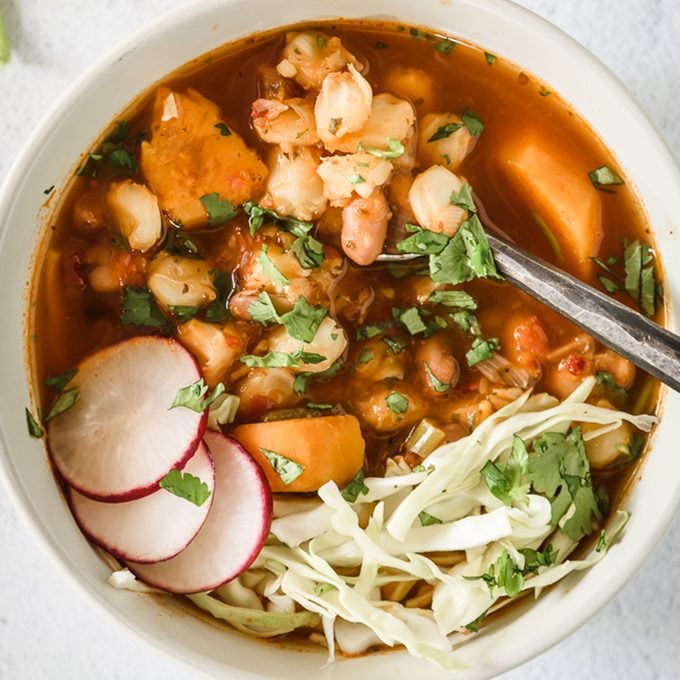
Courtesy of Malena Perdomo, MS, RDN
“During the holidays, the discussion of what to make and why gets interesting in my house as we prepare traditional holiday meals from two cultures—American and Latin dishes,” says registered dietitian nutritionist Malena Perdomo, founder of Malena Nutricion and a certified diabetes educator.
“Pozole is such an amazing recipe to serve for Christmas Eve or New Year, and meat is not required (which makes it planet-friendlier than the pork version, too),” she says.
Serves: 8
Ingredients:
12 ounces white corn pozole (hominy)
4 cups cooked pinto beans
1 sweet potato, peeled, diced
1 yellow onion, divided
8 cups (or 2 quarts) vegetable broth or water
8 dried guajillo chilies, remove stems and seeds
1 jalapeño or serrano pepper, remove stems and seeds
2 fresh Anaheim chilies, remove stems and seeds
1 bell pepper (optional), remove stems and seeds
1 tomato
2 garlic cloves, peeled
1 tablespoon oregano
1 tablespoon cumin
1 teaspoon salt
1 teaspoon black pepper
Toppings: lime wedges, chopped cabbage, sliced radishes, cubed avocado, cilantro
Instructions:
Soak dry pozole in water overnight.
The next day, drain, rinse, and boil pozole in 6 cups of water and then simmer for 2 hours or until corn kernels are soft. If needed, add vegetable broth or more water if there’s not enough broth. After 1 1/2 hours of cooking, add sweet potato and half of the chopped onion.
While the corn continues to cook, remove the stems and seeds from each chili. Place the chilies in a bowl and soak them in boiling hot water until soft. I usually leave them until they can bend easily, about 20 to 30 minutes. Once they are soft do not discard the water.
In a food processor add soft dried chilies, water from the chilies, the rest of the chilies, bell pepper, tomato, garlic, and the rest of the onion. Blend until smooth.
When pozole is soft, add spices, chili sauce, pinto beans, and the remaining vegetable broth or water if it needs more to submerge the pozole. Stir and taste to see if it needs more salt. Cover and cook on low for another 30 minutes.
Serve with lime wedges, cabbage, radishes, avocado, and cilantro.
Pomegranate-glazed Brussels sprouts with pistachios
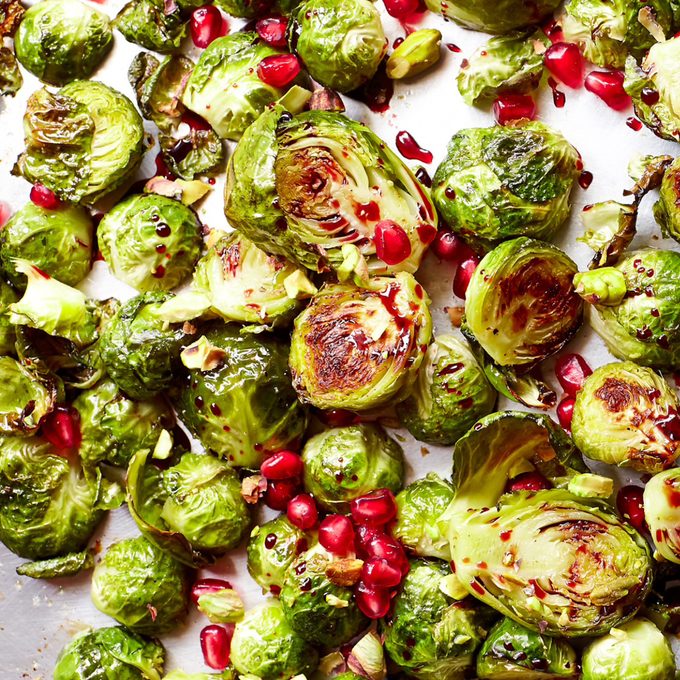
Courtesy of Patricia Bannan, MS, RDN
This red-and-green recipe is festive for the holidays and offers the perfect balance of savory and sweet, according to registered dietitian nutritionist Patricia Bannan, author of From Burnout to Balance.
“I like to use pistachios instead of bacon with roasted Brussels sprouts for an eco-friendly protein source that offers a similar savory crunch,” Bannan says.
“The glaze is simply pomegranate juice, lime juice, and a touch of maple syrup … it gives just the right amount of sweetness and holiday cheer.”
Serves: 6
Ingredients:
3/4 cup 100 percent pomegranate juice
2 tablespoons lime juice
2 tablespoons maple syrup
1 1/2 pounds Brussels sprouts
1/4 cup extra-virgin olive oil
1 teaspoon kosher salt
1/2 teaspoon ground black pepper
3/4 cup pomegranate arils
1/4 cup pistachios, removed from shells and chopped
Instructions:
Make the glaze: Combine the pomegranate juice, lime juice, and maple syrup in a small saucepan and bring to a simmer. Reduce the mixture by half over medium heat until a very thick syrup forms, about 15 minutes. The syrup should coat the back of a spoon. Cool to room temperature and set aside.
Preheat the oven to 400 degrees F/205 degrees C.
Trim bottom of Brussels sprouts, and slice each in half top to bottom. Mix them in a bowl with the olive oil, salt, and pepper. Pour them onto a sheet pan and roast for 20 to 25 minutes, until crisp on the outside and tender on the inside. Shake the pan from time to time to brown the sprouts evenly.
Remove from oven and drizzle immediately with pomegranate glaze. Top with pomegranate arils and chopped pistachios. Serve warm.
Note: For an added kick, top with sweet chili-flavored pistachios.
Apple pie bars
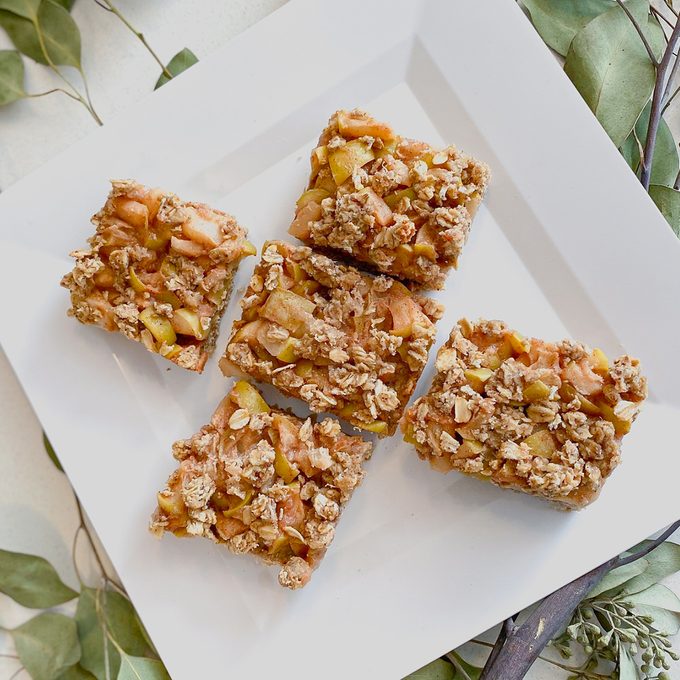
“If you find yourself picking way too many apples this fall, this recipe may be up your alley,” says Jonathan Valdez, owner of Genki Nutrition and media spokesperson for New York State Academy of Nutrition and Dietetics.
“These apple pie bars are apple crisp in bar form, but are easier to carry and don’t have the added sugar and calories you may otherwise add in its dessert form.”
Serves: 15
Ingredients:
2 1/2 cups oats
1 1/2 cup almond flour
1 1/2 cup oat flour (You can blend oats into oat flour.)
1 1/2 bananas, mashed
1/4 cup dates, pitted
1/4 cup hot water
2 teaspoons baking powder
1/2 cup of coconut milk
5 small granny smith apples, diced
2 teaspoons cinnamon
1 1/2 tablespoon arrowroot powder (or cornstarch)
2 teaspoons coconut oil
Instructions:
Preheat oven to 350 degrees F/177 degrees C.
Blend hot water and dates into a paste.
Mix date paste with dough ingredients by hand in a bowl. Form into a dough. Remove 1/3 of dough and set aside. Press the remainder of the dough into a 9-by-13-inch baking dish.
Heat coconut oil in a pot. Add apples and cinnamon. When apples cook down and release water, add arrowroot powder. The apple filling will thicken.
Spread apple filling over the pressed dough. Crumble remainder of the dough over the apple filling.
Bake for 25 minutes. Remove from the oven and let cool completely before cutting.




















